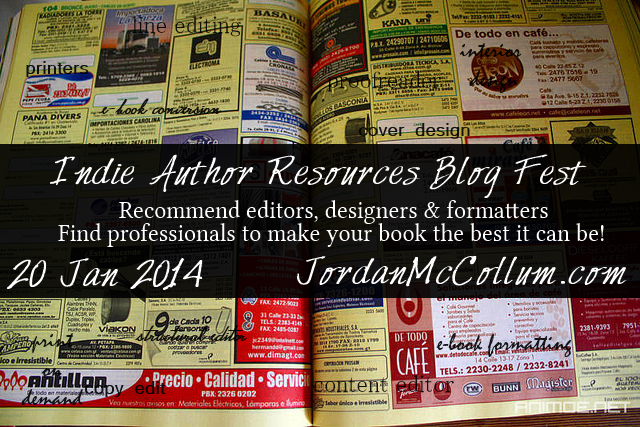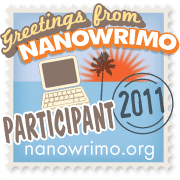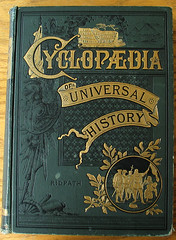When you publish your own works, everything comes down to you. You have to find and hire the editors, proofreaders, cover designer, interior designer, e-book formatter . . . it can be daunting to line up all those other professionals to make your book come to life at last.
I read many great blogs on self-publishing, and I’m not looking to change the overall focus of my blog. However, I do really want to acknowledge the amazing support staff I’ve worked with in producing my books. So I’m putting together the . . . Indie Author Resources Blog Fest!

On Monday, January 20, if you’re an indie author—or if you just happen to know of an editor, cover designer or other publishing professional who does quality work—post about them on your blog, and come back here to link up!
Spread the word
Tell your friends! Copy this and paste it in the HTML of a blog post or your sidebar:
Want it bigger or smaller? Change the number at width="300" to adjust the size.
How to participate
 1. The theme is Indie author resources. It’s all about showing some love for all those people who helped make your book great. So who do you put in your post?
1. The theme is Indie author resources. It’s all about showing some love for all those people who helped make your book great. So who do you put in your post?
- Editors—content, copy, line, and proof
- Designers—cover, interior, e-book, and other promotional graphics
- Formatters—e-book, print
- Printers—print-on-demand, short run, long run, promotional materials
- Any other professionals who helped make your book the best it could be!
Be sure to include links to their websites!
2. If you’re not (yet?) an indie author, but you know exactly who you’d hire, please join in!
3. If you wouldn’t recommend their work, don’t include the person in your post.
4. Post your resources on your blog January 20, 2014, and add it to the Mr. Linky here. Link your post back to the blogfest on here so your readers can read other entries, too. (The link will be http://JordanMcCollum.com/indie-resources/ )
5. Read, enjoy, and comment on other entries!
6. The index! After the blog fest, I’ll be compiling a list of the recommended professionals for ease of use. I’ll link back to all posts, of course!
So, in short: on January 20, write a blog post about an e-book professional, link back here in your post, and sign up on the linkie.
 As I’ve worked on all these things, I’ve had to review all my favorite plotting methods and character posts—on others’ blogs, and on my own. So if you’re getting ready for NaNoWriMo, I’ll be sharing tips, strategies and advice to help you get the most out of your Nano experience.
As I’ve worked on all these things, I’ve had to review all my favorite plotting methods and character posts—on others’ blogs, and on my own. So if you’re getting ready for NaNoWriMo, I’ll be sharing tips, strategies and advice to help you get the most out of your Nano experience. As I’ve worked on all these things, I’ve had to review all my favorite plotting methods and character posts—on others’ blogs, and on my own. So if you’re getting ready for NaNoWriMo, here are some resources on my site that I’ve been thinking about and studying, and I hope they might help you prepare, too.
As I’ve worked on all these things, I’ve had to review all my favorite plotting methods and character posts—on others’ blogs, and on my own. So if you’re getting ready for NaNoWriMo, here are some resources on my site that I’ve been thinking about and studying, and I hope they might help you prepare, too. )
)

 I’m getting ready to make our series on plotting into a free PDF. In one of my
I’m getting ready to make our series on plotting into a free PDF. In one of my 
 The next step is getting the reader to support the character’s goals and aspirations. While a character doesn’t have to be admirable, Frey stresses, the easiest way to get readers to support a character’s goal is to make sure their goal is noble.
The next step is getting the reader to support the character’s goals and aspirations. While a character doesn’t have to be admirable, Frey stresses, the easiest way to get readers to support a character’s goal is to make sure their goal is noble.  This doesn’t mean that every sad sack character should be trudging through the pouring rain (to the courthouse to try to win his freedom from a wrongful conviction)—though it might help. It does mean, however, that it helps for the character to take notice of his environs, and for them to mirror (or, possibly, contrast or mock) his internal emotional state.
This doesn’t mean that every sad sack character should be trudging through the pouring rain (to the courthouse to try to win his freedom from a wrongful conviction)—though it might help. It does mean, however, that it helps for the character to take notice of his environs, and for them to mirror (or, possibly, contrast or mock) his internal emotional state.